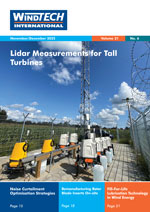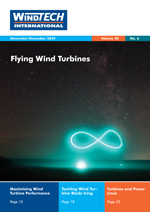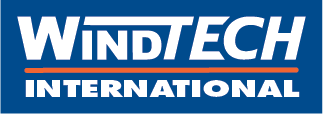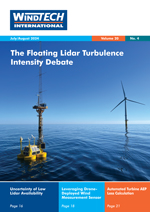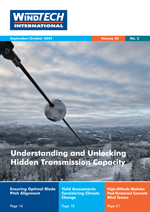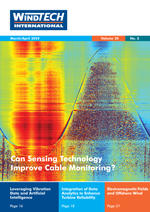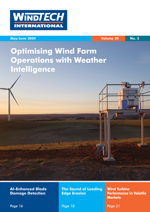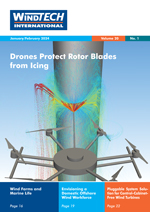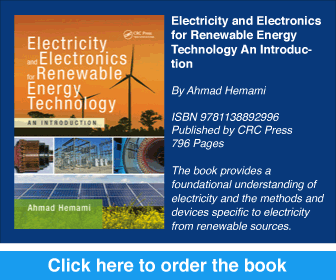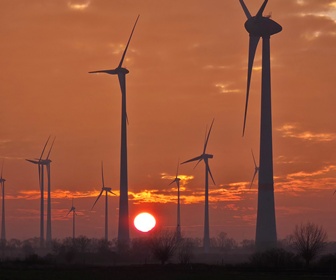- Category: 2024
The Front CoverKitekraft develops technology to generate energy from flying wind turbines. Kitekraft’s flying wind turbines consist of three main components: a ground station, a flying kite, and a tether connecting the two. While the kite is flying horizontal figures of eight perpendicular to the wind, it produces power with small on-board rotors. On page 6 you can read more about this solution. The image on the cover is a long exposure shot of a flying system illustrating the flight trajectory of the kite. Publisher's NoteThe impact of Trump’s re-election on onshore and offshore wind energyFeaturesFlying Wind Turbines
By Christoph Drexler, Co-founder and Head of Business Development, Kitekraft, Germany By Samuel Davoust, Co-founder and Science Lead, Tipspeed, France
By Dylan Baxter, PEng, Director of Technology for BorealisWind, FabricAir, Canada By Chris Hyde, Meteorologist, Meteomatics, USA
Windtech FutureSmart Financial DecisionsBy Ahmad Hemami, McGill University, Montreal, Canada View from InsideBy Savannah Altvater, Head of Unit of Distribution and Market Facilitation, Eurelectric, Belgium Latest News
|
|
||||||||||||||||||||||
- Category: 2024
The Front CoverFloating lidar systems have revolutionised the offshore wind industry by enabling the bankability of projects at a fraction of the original cost – successful wind resource assessment campaigns are essential for the economic viability of the wind farm development process. However, one parameter measured in such campaigns – turbulence intensity – is at the centre of debate. At page 6 you can read more about this topic. The image on the cover shows the EOL-FLS200 deployed at the TNO offshore fixed-reference verification site. (https://offshorewind-measurements.tno.nl/en/fls/) Publisher's NoteTraditional oil and gas companies backing out of wind energyFeaturesThe Floating Lidar Turbulence Intensity Debate
By Adrià Miquel and Giacomo Rapisardi, Eolos Floating Lidar Solutions, Spain By Pyry Pentikäinen, Adviser, Kjeller Vindteknikk, Finland
By Itay Mor, Boaz Peled, Alex Alpert, and Guy Yakir at First Airborne, Israel By Nicholas Gaudern, Chief Technology Officer, PowerCurve, Denmark
Windtech FutureLessons for the Future of Wind EnergyBy Ahmad Hemami, McGill University, Montreal, Canada View from InsideBy Dennis Nderitu, Energy Systems Manager, GEAPP Latest News
|
|
||||||||||||||||||
- Category: 2024
- Category: 2024
The Front CoverFibre-optic sensing has proven its worth over the last decade in protecting the cable from over-temperature events, and distributed temperature sensing (DTS) is now very uch essential kit. Industry advances in the deeper analysis of DTS and benefits from the adoption of sister technology – distributed acoustic sensing – are bringing some huge advances in understanding cable condition. In the article on page 6, you can read more about this technology. The image on the cover was recorded by Indeximate Ltd on a UK export cable. Publisher's NoteReturning to profitabilityFeaturesCan Sensing Technology Improve Cable Monitoring?
By Dr Chris Minto, co-founder, Indeximate Ltd, UK By Thiago Kleis, Global Sales Executive, AQTech, Portugal
By Pieter-Jan Daems, Cédric Peeters and Jan Helsen, Vrije Universiteit Brussel, Belgium By Daniel Dawson and Damian Preziosi, Integral Consulting, USA
Windtech FutureIs This Similar to The Gearbox Problem?By Ahmad Hemami, McGill University, Montreal, Canada View from InsideBy Shaun Reardon, Principal Cybersecurity Consultant, DNV, Norway Latest News
|
|
||||||||||||||||||||||||||||
- Category: 2024
The Front CoverReliable atmospheric intelligence ensures that wind farm operators can proactively protect assets, mitigate hazards and maximise performance, even in the most challenging conditions. Without accurate weather monitoring capabilities, mechanical strains, physical damage and lost production can result in millions of dollars in repair costs and lost revenue for wind farm owners and operators. Read more about this topic on page 6. The image on the cover shows a WindCube Scan scanning lidar (photo courtesy of University of Melbourne). Publisher's NoteIs the EU’s investigation into Chinese wind turbine manufacturers justified?FeaturesOptimising Wind Farm Operations with Weather Intelligence
By Matthieu Boquet, Head of Wind Operations, Vaisala, France By Kevin Lind, Chris Simpson and Emma Hemus, Perceptual Robotics, UK
By Obdulia Ley, Subject Matter Expert in Acoustic Emission, Mistras Group, USA By Andreas Bechmann, Senior Scientist, DTU Wind and Energy Systems, Denmark
Windtech FutureElectric power from very far offshore wind farmsBy Ahmad Hemami, McGill University, Montreal, Canada View from InsideBy Justin Canup, Director of Business Development North America, Spares In Motion, USA Latest News
|
|
||||||||||||||||||||||||||
- Category: 2024
The Front CoverThe research project Temporary Coating by Means of Drones – Icing Protection of Wind Turbines as a Case Study was carried out by Fraunhofer IFAM and IPA (page 6). The project involved 19 companies. The aim of the project was to provide the material technology basis for a temporary anti-ice coating and a drone-compatible application. The cover image shows a simulation of coating using a drone under the influence of wind. (source: Fraunhofer IPA) Publisher's NoteAdvances and challenges in Europe’s offshore wind energy sectorFeaturesDrones Protect Rotor Blades from Icing
By Andreas Stake and Oliver Tiedje, Fraunhofer, Germany By Frank Thomsen, Lars O. Mortensen, Naomi A.M. Tuhuteru, Jonas B. Mortensen, DHI, Denmark
By Nick Zenkin, Lead Offshore Wind Consultant, Xodus Group, USA By Andreas Franke, Business Manager Wind Energy, Beckhoff Automation, Germany
Windtech FutureIs Using DFIG in Wind Turbines an Obsolete Technology?By Ahmad Hemami, McGill University, Montreal, Canada View from InsideBy Shovana Talukdar, Senior Consultant, BVG Associates Latest News
|
|
||||||||||||||||||||



